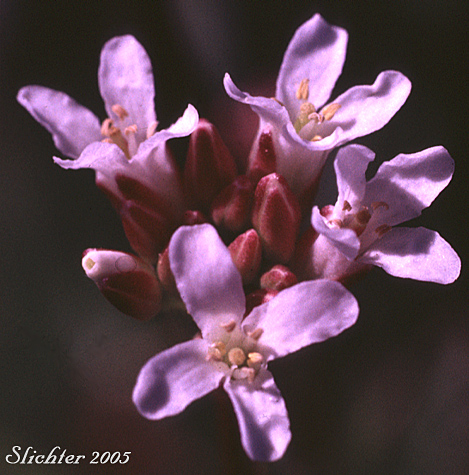
Eschscholtz's hairy rock cress is a biennial or short-lived perennial. One to several simple stems arise from a strong taprot to a height of 100 cm. The lower part of the plant is strongly haired with simple or a few forked hairs, but the herbage is smooth above. The leaves are found primarily on the stems. The basal leaves are oblanceolate or obovate-spatulate with short, winged petioles and entire to serrate margins. The basal leaves are 2-8 cm long. The 5-15 stem leaves are auriculate and sessile, ovate-lanceolate to lanceolate-elliptic, as much as 3 cm wide and 2-12 cm long.
The 4 sepals are 3-5 mm long. The 4 white or creamy petals are 4-9 mm long. The inflorescence is a many-flowered raceme. The seed capsules are long, linear siliques, from 3-8 cm long and 1-2 mm wide. The siliques are erect.
Var. glabrata: Petals generally over 5 mm in length. Stem leaves mostly entire. Stigma nearly entire and Siliques 1-1.3 mm wide. Usually found in the mountains, usually not coastal. Found from British Columbia to California.
Var. eschscholtziana: Petals generally over 5 mm in length. Stem leaves (especially lower ones) usually toothed. Stigma lobed and siliques 1.3-2 mm wide. Often along coast and in lower coastal mountains. Found from Alaska to southern Oregon.
Eschscholtz's hairy rock cress is found in forests and forest openings at all elevations.
Eschscholtz's hairy rock cress is found from the Arctic south through much of North America to California, Arizona, and New Mexico, and as far east as the mid-Atlantic states.
Eschscholtz's hairy rock cress as seen along the Angel's Rest Trail in the Columbia River Gorge, early May 2005.